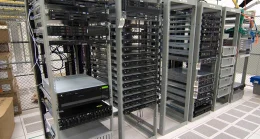The Difference Between General and Specific Site Surveys
A site survey by one of the team at Server Room Environments can cover many aspects of a site and its critical infrastructure systems. The survey may be carried out on a ‘green field’ or ‘brown field’ site for a new build or refurbishment, system upgrade or end-of-life decommissioning and recycling.
We provide free site surveys across the UK and Eire and these are generally free of charge and scheduled to suite the diaries of our project managers. The site survey team includes product specialists who are experts in their field and who can also provide general information and guidance on the other products, systems and services we provide. We have experts in critical power, as well as experts in critical cooling and both are trained in energy efficiency as this is a relevant topic in both product groups. Our project management team also includes specialists in electrical power installations, datacentre energy efficiency and even the field of power harmonics pollution.
It is a big commitment to keep our project management team up to date on the latest technologies and efficiency measures deployed within the server room and datacentre and related industries. However, it is only by giving this commitment and investing time and money in training and education that we can ensure we provide one of the most comprehensive site surveys and product and services ranges in the industry.
To arrange a site survey, simply complete our website enquiry form or call our project management team. We typically like to get to site within 24 hours (working) of a request and will endeavour to meet a client’s time frames and needs.
Site Surveys
A site survey can be viewed as an inspection of a building like a datacentre or a part of a building such as a server room where work is proposed. The work element could be the installation of a new system, upgrade or decommissioning of an existing system. The work could be to identify areas for improvement such as an energy efficiency audit, cooling system review or to identify power problem sources. A site survey can have several more specific aims which can include:
- To scope out the project in terms of the work required
- To identify obstacles and problems that could hinder project delivery
- To determine location, access, logistics and orientation
- To determine connection points and cable points
- To determine electrical power, lighting and cooling works
- To determine room requirements in terms of ambient and humidity or security
- To determine room works in terms of raised access floors and ceilings
The outcome from a site survey should be a project proposal with costings and a quotation. Some of pricing may only be ‘estimated’ at this stage and further analysis may be required for a completely costed proposal. To proceed to the next stage some companies may require what is known as a stage payment to cover a potential design stage or project deposit. At Server Room Environments, we provide several site survey types.
General Site Surveys For Costed Proposals
An example of a general site survey is one to determine the best way to protect the critical power path within a datacentre or for a server room. A critical power site survey is carried out when planning for the installation of an uninterruptible power supply and/or standby power generating set installation.
A typical critical power site survey will last around 1-2 hours but can extend to a longer time frame if access is delayed or there are health & safety briefings or other meetings required on site.
For a critical power site survey, site information that could be useful includes electrical connection diagrams and schematics, equipment layouts and the specifications and maintenance records of any power protection systems already installed on site.
During the critical power site survey, the following topics will be addressed:
- Room layouts and dimensions
- Floor loading and server cabinet layouts
- Cabling requirements including trunking and cable trays
- Load profile and electrical supply characteristics
- Known site power problems and hardware failures
- Location and environmental considerations
- Existing power protection and lighting and surge protection systems
- Existing LV switchboard review and critical power path hot-spots
- Delivery access, routes and logistics arrangements
- Plant rooms and generator fuel storage and environmental concerns
- Network interface and building management system connections
- Site specific health and safety, security and environmental requirements
- Maintenance plan requirements and service arrangements
- On-site load bank and site testing including temporary power supplies
For any site survey, load profiling can be an issue. Our project managers solve this using load analysers and profilers that can accurately measure true RMS values for IT loads including servers, PCs, terminals and network peripherals.
A final aspect the survey could identify is equipment and systems to be decommissioned and removed for recycling or to be used for a trade-in discount or rebate.
Problem Solving Power Quality Surveys
This is another type of survey and one that is more focused than a general site survey. A power quality survey is aimed at identifying the causes of power problems on site and with a building’s mains power supplies and possible interaction with load power supplies within the building itself. Servers could be failing catastrophically or data corruption occurring or power supplies operating erratically.
A power quality survey can provide an instant overview but more than likely will require a picture to be built up over several days or weeks. A power quality survey can take longer to arrange and will require more specific equipment in the form of a mains monitor device, power analyser and/or data loggers.
The outcome from a power quality survey will be to identify any site-specific power problems. These can include sags, surges, brownouts, transient voltages, harmonics and power failures and electrical characteristics including power factor issues.
A power quality site survey can be used to assess brown-field and existing sites and help with assessments to relevant local standards and guidelines including G5/4. The outcome of the audit should be a costed action plan that clearly identifies problems and provides potential power solutions to mitigate or remove issues.
Power quality surveys are more extensive than a general site survey and a such can require a risk assessment and method statement (RAMS) as part of the kick-off meeting. The RAMS are important because at some stage of the survey it will be necessary to connect monitoring devices to electrical points which could include: the point of common coupling (PCC) for G5/4 assessments, LV busbars, sub-metering points, distribution panels, PDUs and server power cords. Every measure must be taken to ensure safety and prevent disruption to any power related service.
Whether you need a general site survey to discuss a potential project or want a more specific audit and assessment, timing is often important both to you and the assigned project manager.
At Server Room Environments, we do try to ensure our UPS system and cooling site surveys are not charged for when they can be diary booked to meet all our other project managers commitments. More specific audits and especially those requiring the use of dedicated monitors and data loggers are typically chargeable.

























